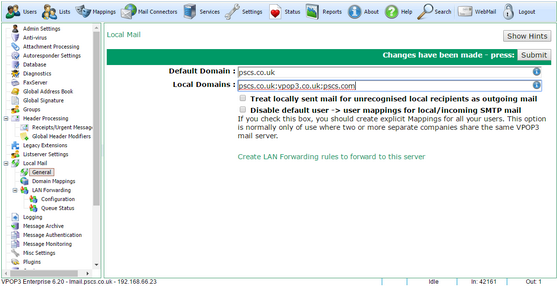
To get to this page, go to Settings → Local Mail → General
This page lets you set how local mail is handled. Local mail is mail from one local user to one or more other local users. If a message is sent to local users and remote users, then the local recipients will be handled according to the settings here, and remote recipients will be treated as outgoing mail.
The Default Domain is the domain name to be added to addresses which don't have a domain explicitly defined. For instance, if there is a user called 'bob' who sends a message from VPOP3's Webmail, then the sender address will default to bob@<default domain>. So, this should be your 'main' domain. This can be overridden for specific instances if necessary, but in most cases, an organisation will have a single main domain, so defining it here simplifies administration.
Note - the Default Domain is a SINGLE domain. If you specify more than one domain here, you WILL have problems!
The Local Domains setting indicates which domains VPOP3 should treat as for local users. So, mail addressed to the domain(s) specified here will be handled internally by VPOP3 and will not go out to the Internet. VPOP3 checks this for all mail it receives using SMTP, so that means locally sent messages or messages which are received through an incoming SMTP feed. This can be overridden for specific addresses using *REMOTE mappings. So, in the above screenshot, mail for anyone@pscs.co.uk, anyone@vpop3.co.uk and anyone@pscs.com will be handled internally by VPOP3. You can use full email addresses or wildcards here if you wish, but that is rarely appropriate. *@pscs.co.uk is equivalent to pscs.co.uk, but the latter is more efficient.
If the Treat locally sent mail for unrecognised local recipients as outgoing mail option is checked, then if a local user sends a message to an email address on a local domain, but that address does not exist either as a User, List or Mapping, then VPOP3 will put it into the Outqueue to be sent to the Internet. This is sometimes needed, but not often, so make sure it is really what you need. If there is not another mail server which will handle these addresses, then the messages will just come back into VPOP3 (eg through a catch-all account) and cause errors. It is usually better to specifically list remote email addresses using *REMOTE mappings if necessary.
The Disable default user -> user mappings for local/incoming SMTP mail option can be used if you want to explicitly define Mappings for email routing. Normally, a user will have an automatic email address of <username>@<local domains>, but this option removes that automatic email address mapping. So, if you have a VPOP3 user called bob and your Local Domains is set to example.com, if you don't do anything else, local or incoming SMTP mail for bob@example.com will be delivered to the bob mailbox. In most cases this is desirable, but in some cases it may not be. For instance, if you have several domains with different users with the same "user" part of their email address.
For example, if you have two domains example.com and example.net and two email addresses bob@example.com and bob@example.net where mail to those addresses goes to different mailboxes bob1 and bob2. You can create Mappings of bob@example.com -> bob1 and bob@example.net -> bob2. That will achieve what you need, but if the Local Domains is set to example.com;example.net, mail for bob1@example.com and bob1@example.net will also go into the bob1 mailbox, and so on, which may be undesirable. By checking the Disable default user -> user mappings option, you make it so that only the explicit Mappings will take effect.
The Create LAN Forwarding rules to forward to this server link will let you create a set of rules which you can import to another VPOP3 server so that it will LAN Forward messages to users on this server. You can use this to help configuration if you have two (or more) VPOP3 servers which you want to send messages between using LAN forwarding.

